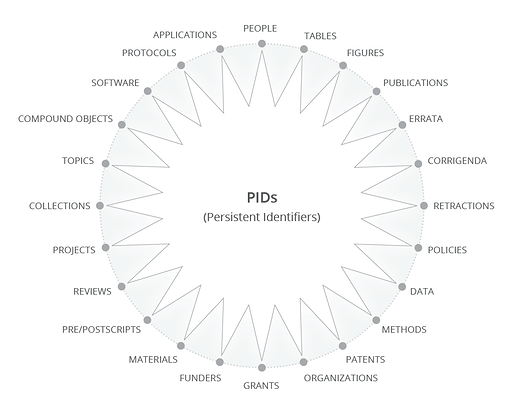Publishers manage the scholarly record through publication and syndication. As part of this process, creating and cataloguing persistent identifiers related to that record is of critical importance. This solidifies the scientific record and publication process, and allows scholarly assets to be easily found, referenced, and claimed. Persistent identifiers, or PIDs, can relate to publications, scientific assets (like data or figures), elements used in the scientific work, or even people. To find out more about the origins of persistent identifiers (including the print era) see this post and this Wikipedia page.
Perhaps the best known and earliest digital PID used by publishers is the Digital Object Identifier (DOI). The benefits of using DOIs are too numerous to list here, but include:
- Ensuring scholarly content is discovered wherever it is located and whoever it is published by
- Enabling usage reporting of a specific article over its entire lifecycle, wherever it is located
- Enabling the recording of DOIs citing other DOIs. (“Event data”)
- Enabling the precise citation of a specific object, e.g. a subset of an article like a figure or a table
- Enabling the 2-way connection of articles with datasets that are published on data platforms
And, perhaps the second best known PID is ORCiD, which is an identifier for individual people doing scholarly and research work. The benefits of researchers and publishers engaging with ORCiD include:
- Simply–recording precisely who did what and when
- Disambiguation of authors with the same or similar names
- Reliable consolidation of outputs to an author whose name is inconsistently written or spelled
- Reliable consolidation of outputs to an author whose name changes, or whose name does not follow Global North/Western naming conventions
Publishers operate between and among authors, reviewers, readers, funders, repositories, institutions, and companies. Therefore, publishers are in a unique position to influence the awareness and adoption of PIDs. Publishers who always assign DOIs to scholarly content and who encourage, or insist on, authors, reviewers, and editors using ORCiDs when doing work in their systems, enable all of the research community to better connect, study, and understand the full picture of research and scholarship. Also, they enable themselves to study and understand their own part in this picture, such as their strengths, weaknesses, and opportunities. There is no better illustration of the power of PIDs than seeing them work in practice, rather than just in theory.
Importantly, PIDs do not end with scholarly objects (DOIs) and people (ORCiDs). Just as publishers have pioneered the use and demonstrated the benefits of DOIs and ORCiDs, the full suite of PIDs should also be encouraged by publishers. The graph below is a current snapshot of the potential scope of PIDs.
[For more on how these PIDs can, and should, connect together, see the PID Graph at https://www.project-freya.eu/en/pid-graph/the-pid-graph.]
It is hard to exactly define the future of PIDs, but emerging and potential uses include:
- Reviewers connecting their ORCiDs to their peer reviews so that they can get credit for reviewing (ORCiD Setup; Credit for Peer Review in practice at PLOS)
- All funders and grants having PIDs so that researchers, datasets, and articles can be connected to the funders and grants that made them possible. (Grant ID in practice.)
- Research Organization Registry - a community-led project to develop an open, sustainable, usable, and unique identifier for every research organization in the world, so we can reliably understand and monitor where research is emanating from. (Discussion of use at Dryad.)
